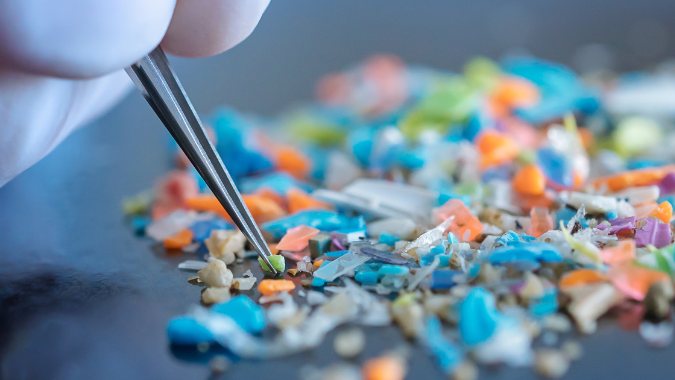In the modern world, plastics are everywhere. From the packaging of our food to the clothes we wear, plastic has become an essential part of daily life. However, recent research has shed light on a growing concern: the potential impact of nano- and microplastics on human health. These tiny particles, too small to be seen by the naked eye, are finding their way into our bodies through the air we breathe, the water we drink, and the food we eat.
What Are Nano- and Microplastics?
Nano- and microplastics are extremely small particles of plastic that are released into the environment through the breakdown of larger plastic items. Microplastics are defined as particles measuring between 1 micrometer (µm) and 5 millimeters (mm) in size, while nanoplastics are even smaller, with a size range of 1 nanometer (nm) to 1 µm.
These particles are present in our surroundings due to the widespread use of plastics. The most common sources include plastic packaging, synthetic clothing, and industrial materials. When these items degrade, they release tiny particles into the environment, contaminating water, air, and soil. The particles can also be created directly during manufacturing processes, such as the production of cosmetics and personal care products that contain microbeads.
How Do Nano- and Microplastics Enter Our Bodies?
There are three primary routes through which nano- and microplastics can enter the human body:
- Ingestion: Contaminated food and water are the main sources of plastic particles in the digestive system. Research has found microplastics in bottled water, tap water, seafood, and even common household foods like salt and sugar. A striking example is a study that revealed 81% of 159 global tap water samples contained microplastics. On average, humans are estimated to ingest around 0.1–5 grams of microplastics per week — roughly equivalent to the weight of a credit card.
- Inhalation: Airborne microplastics, primarily from synthetic fabrics, road dust, and industrial processes, can be inhaled. Studies have detected plastic particles in human lung tissue, raising concerns about respiratory health.
- Dermal Exposure: Skin contact with plastics through everyday items like clothing and cosmetics can also expose the body to these tiny particles. However, current research suggests that only the smallest nanoparticles may penetrate the skin’s outer layers.
Potential Health Risks
Although research on the effects of nano- and microplastics on human health is still in its early stages, the available evidence is troubling. Here are some of the potential health impacts associated with exposure to these particles:
- Respiratory Issues: Inhalation of nano- and microplastics has been linked to various respiratory conditions, including lung cancer, asthma, and hypersensitivity pneumonitis. Studies have shown that microplastic fibers can accumulate in lung tissue, potentially causing inflammation and fibrosis. Workers exposed to high levels of airborne plastic particles, such as those in the plastics manufacturing industry, have reported increased rates of respiratory diseases like obstructive bronchiolitis.
- Digestive Problems: The gastrointestinal tract is a major entry point for microplastics through ingestion. There is evidence that these particles may disrupt gut microbiota and contribute to conditions like inflammatory bowel disease (IBD). Some studies have found a positive correlation between the concentration of microplastics in stool samples and the severity of IBD.
- Neurological Effects: Exposure to certain types of plastics, especially in occupational settings, has been linked to neurotoxic effects, including symptoms like headache, fatigue, and dizziness. Long-term exposure to plastic-related chemicals like styrene has been associated with degenerative neurological disorders.
- Reproductive Harm: Animal studies suggest that microplastics may negatively affect reproductive health. For example, exposure to microplastics has been shown to cause granulosa cell apoptosis (cell death) and fibrosis in the ovaries of rats. There is also evidence that plastic particles can cross the placental barrier and accumulate in fetal tissues, raising concerns about potential developmental effects in humans.
- Cancer Risk: Certain types of plastics and their chemical components, such as bisphenol A (BPA), are known to be carcinogenic. Studies have suggested that long-term exposure to microplastics may increase the risk of cancers, including colorectal and pancreatic cancer.
What Can Be Done?
The growing body of research on nano- and microplastics has raised significant concerns about the long-term impacts of plastic pollution on human health. However, more studies are needed to fully understand the extent of these risks and to establish safe exposure limits.
In the meantime, there are steps that individuals and governments can take to reduce exposure to these harmful particles:
- Reduce Plastic Use: Limiting the use of single-use plastics and opting for natural, biodegradable alternatives can help reduce the amount of plastic waste entering the environment. This, in turn, may decrease the amount of nano- and microplastics that end up in our food, water, and air.
- Improve Waste Management: Better waste management practices, including increased recycling and the development of biodegradable plastics, can help mitigate plastic pollution. Governments and industries should invest in technologies that reduce plastic waste and promote more sustainable alternatives.
- Raise Public Awareness: Educating the public about the risks of nano- and microplastics is essential. By making informed choices about the products we use and the way we dispose of plastics, we can all contribute to reducing plastic pollution and protecting our health.
- Regulatory Action: Governments must implement stricter regulations on plastic production, use, and disposal. This includes banning harmful chemicals used in plastic manufacturing and setting limits on the amount of plastic particles that can be released into the environment.
Conclusion
Nano- and microplastics are an invisible but potentially dangerous aspect of modern life. While more research is needed to fully understand their impact on human health, the existing evidence suggests that these tiny particles may pose significant risks. By reducing plastic consumption, improving waste management, and raising awareness, we can take steps to protect both the environment and our health from the harmful effects of plastic pollution.
Source: The potential impact of nano- and microplastics on human health: Understanding human health risks

